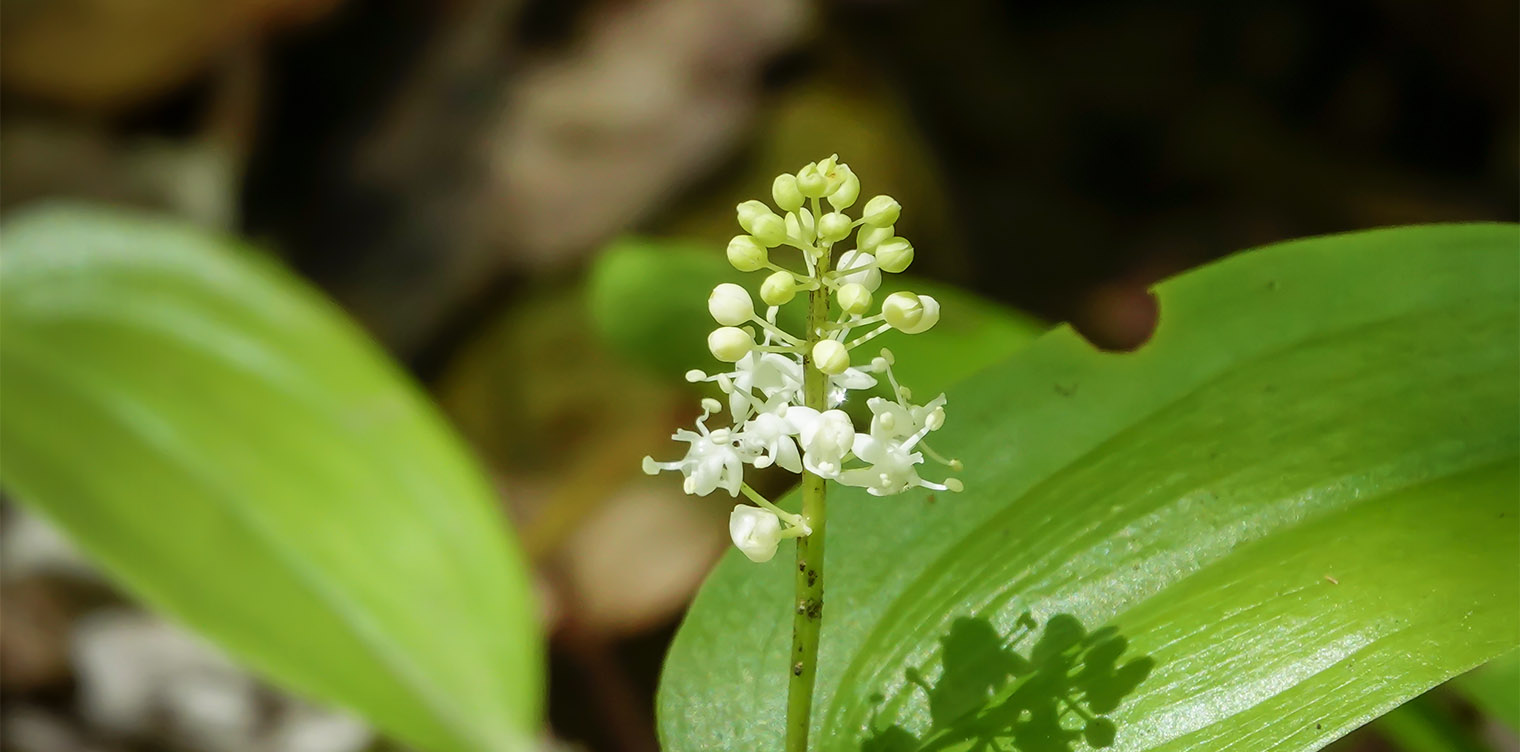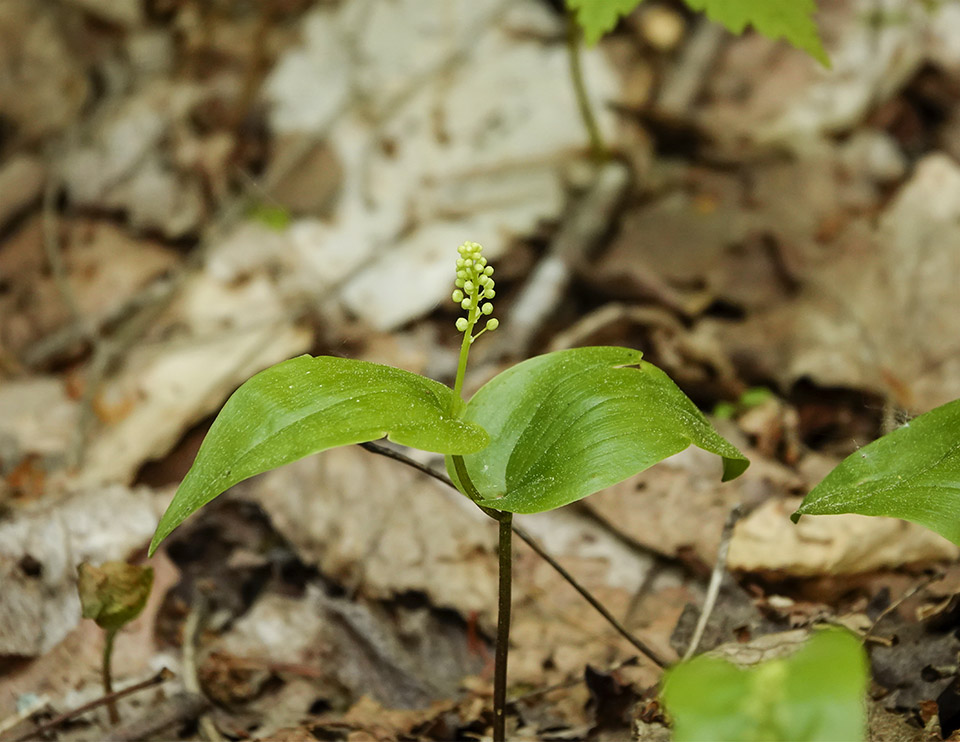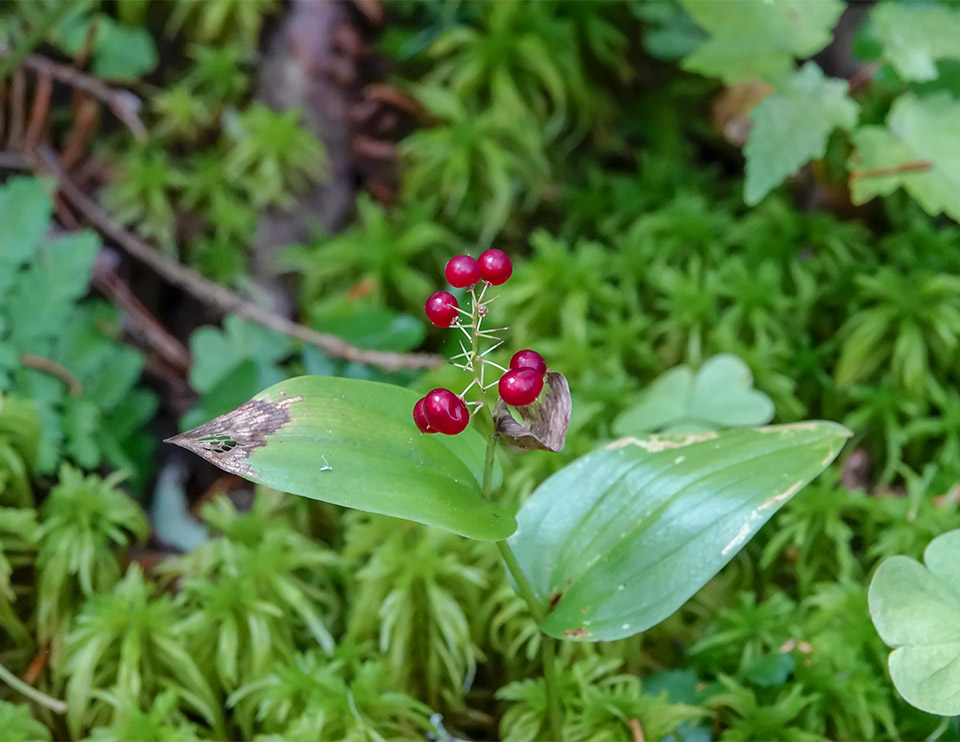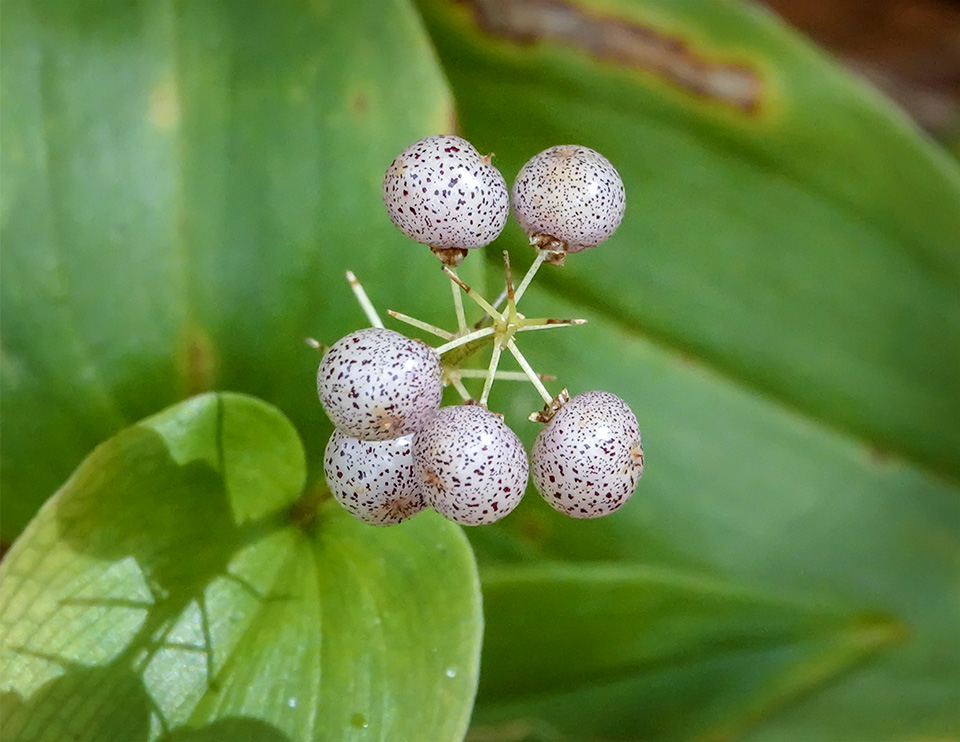Wildflowers of the Adirondacks:
Canada Mayflower (Maianthemum canadense)

Canada Mayflower (Maianthemum canadense) is a low-growing wildflower which produces frothy white flowers in late spring and flourishes in mixed wood forests in the Adirondack Mountains of upstate New York. It is a member of the Lily family (Liliaceae).
The Latin name (Maianthemum) comes from two Greek words: maios (May) and anthemom (blossom), a reference to its flowering times in parts of its range. Canada Mayflower is also known as False Lily-of-the-Valley, Two-leaved Solomon's Seal, Canadian May-lily, Wild Lily-of-the-Valley, and Canada Beadruby. The latter name refers to the color and shape of the plant's berries. This species is listed as threatened in Kentucky and endangered in New Jersey.
Identification of Canada Mayflower

Canada Mayflower is a low-growing plant, usually under six inches tall. This species spreads by rhizomes and frequently forms carpet-like colonies.
Canada Mayflower has delicate, slightly zigzagging stems up to six inches tall, with one to three shiny, oviate, dark green leaves. The leaves are rounded and taper to sharply pointed tips. They have heart-shaped or broadly rounded bases that tend to clasp the stem.
In late-spring and early summer, Canada Mayflowers produce a cluster of tiny white, fragrant flowers held in upright clusters on separate, delicate stems. Each flower is 1/8" long and has two petals, two small, petal-like sepals, and four stamens. Plants with only one leaf are immature and will not flower until the second year. The Canada Mayflower's frothy white flowers are somewhat similar to those of Foamflower, but the leaves of the Foamflower are very different, with angular lobes and coarse irregular teeth.

Canada Mayflower usually doesn't start blooming until very late May or early June. A tally of flowering dates for the upland Adirondack areas compiled by Michael Kudish, based on data collected from the early seventies to the early nineties, lists the earliest flower date as 2 June, the median date as 7 June, and the latest date as 16 June. In recent years, Canada Mayflower has been blooming a few days earlier.
Later in the summer, the flowers become small berries with one to two seeds. The berries are initially green with spots, then turn a mottled dull red in late summer and red in fall. The berries, which are about 1/8 inch wide, may be poisonous.
Uses of Canada Mayflower
Canada Mayflower has very limited edible uses. Other than the Potawatomi, said to eat the berries, there are no reports that native American groups used the plant as food.
Medicinal uses of Canada Mayflower are also very limited, compared to many other plant species. Several groups used the plant for headache and sore throat. The Iroquois are said to have used a decoction of the roots for kidney ailments.
Wildlife Value of Canada Mayflower

Canada Mayflower is not a major wildlife food. The translucent red berries are eaten to a limited extent by wildlife, including Ruffed Grouse, Canada Jays, Eastern Chipmunks, and White-footed Mice. Snowshoe Hares have been known to consume the leaves to some extent.
Distribution of Canada Mayflower
The range of the Canada Mayflower extends from northern British Columbia and Alberta and southeastern Montana and Wyoming eastward to the Atlantic Coast. Its range continues southward in the Appalachian Mountains to Tennessee.
Canada Mayflower is found in most New York State counties and virtually all counties in the eastern part of the state. This species is present in all counties within the Adirondack Park Blue Line.
Habitat of Canada Mayflower
Canada Mayflower grows a variety of soil types. It is a shade-tolerant species and has been found in a wide range of sunlight levels, although it may do best in partial shade. This plant can grow in well-drained to imperfectly drained soils. Canada Mayflower is considered a late successional species, but has been found in the understory of forest stands of all ages. It recovers rather slowly after fire.
Given Canada Mayflower's rather flexible requirements, it is not surprising that it is found in a wide variety of habitats, including conifer, hardwood, and mixed wood forests, as well as hummocks in swamps and higher-elevation spruce-fir forests to the timberline. This plant is classified as a facultative species, which means that it occurs in wetlands and non-wetlands.
In the Adirondacks, Canada Mayflower is found in a wide variety of ecological communities:
- Alpine Krummholz
- Appalachian Oak-Pine Forest
- Beech-Maple Mesic Forest
- Hemlock-Hardwood Swamp
- Hemlock-Northern Hardwood Forest
- Limestone Woodland
- Mountain Fir Forest
- Mountain Spruce-Fir Forest
- Northern White Cedar Swamp
- Open Alpine Community
- Pine-Northern Hardwood Forest
- Pitch Pine Heath Barrens
- Red Pine Rocky Summit
- Spruce-Fir Swamp
- Spruce Flats
- Spruce-Northern Hardwood Forest
You can find Canada Mayflower growing in mixed wood forests along parts of virtually all of the trails covered here, growing alongside Bunchberry, Twinflower, and Wild Sarsaparilla.
References
Michael Kudish. Adirondack Upland Flora: An Ecological Perspective (The Chauncy Press, 1992), pp. 23-28, 42, 230.
New York Flora Association. New York Flora Atlas. Canada Mayflower. Maianthemum canadense Desf. Retrieved 9 April 2025.
United States Department of Agriculture. The Plants Database. Canada Mayflower. Maianthemum canadense Desf. Retrieved 9 April 2025.
United States Department of Agriculture. Fire Effects Information System (FEIS). Species Reviews. Maianthemum canadense. Retrieved 9 April 2025.
Flora of North America. Maianthemum canadense Desfontaines. Retrieved 9 April 2025.
New York State. Department of Environmental Conservation. New York Natural Heritage Program. Ecological Communities of New York State. Second Edition (March 2014), pp. 71, 74-75, 92-93, 101-102, 104-105, 105-106, 109, 118, 119-120, 121, 121,122, 123, 123-124, 124. Retrieved 9 April 2025.
New York Natural Heritage Program. 2025. Online Conservation Guide for Alpine Krummholz. Retrieved 9 April 2025.
New York Natural Heritage Program. 2025. Online Conservation Guide for Appalachian Oak-Pine Forest. Retrieved 9 April 2025.
New York Natural Heritage Program. 2025. Online Conservation Guide for Beech-Maple Mesic Forest. Retrieved 9 April 2025.
New York Natural Heritage Program. 2025. Online Conservation Guide for Hemlock-Hardwood Swamp. Retrieved 9 April 2025.
New York Natural Heritage Program. 2025. Online Conservation Guide for Hemlock-Northern Hardwood Forest. Retrieved 9 April 2025.
New York Natural Heritage Program. 2025. Online Conservation Guide for Limestone Woodland. Retrieved 9 April 2025.
New York Natural Heritage Program. 2025. Online Conservation Guide for Mountain Fir Forest. Retrieved 9 April 2025.
New York Natural Heritage Program. 2025. Online Conservation Guide For Mountain Spruce-Fir Forest. Retrieved 9 April 2025.
New York Natural Heritage Program. 2025. Online Conservation Guide for Northern White Cedar Swamp. Retrieved 9 April 2025.
New York Natural Heritage Program. 2025. Online Conservation Guide for Open Alpine Community. Retrieved 9 April 2025.
New York Natural Heritage Program. 2025. Online Conservation Guide for Pine-Northern Hardwood Forest. Retrieved 9 April 2025.
New York Natural Heritage Program. 2025. Online Conservation Guide for Pitch Pine-Heath Barrens. Retrieved 9 April 2025.
New York Natural Heritage Program. 2025. Online Conservation Guide for Red Pine Rocky Summit. Retrieved 9 April 2025.
New York Natural Heritage Program. 2025. Online Conservation Guide for Spruce Flats. Retrieved 9 April 2025.
New York Natural Heritage Program. 2025. Online Conservation Guide for Spruce-Northern Hardwood Forest. Retrieved 9 April 2025.
New York State. Adirondack Park Agency. Preliminary List of Species Native Within the Adirondack Park Listed Alphabetically by Scientific Name and Sorted by Habit. Volume 1. Updated 10.23.2006, p. 27. Retrieved 9 April 2025.
National Audubon Society. Field Guide to North American Wildflowers. Eastern Region. (Alfred A. Knopf, 2001), pp. 608-609, Plate 147.
Mark J. Twery, at al. Changes in Abundance of Vascular Plants under Varying Silvicultural Systems at the Forest Ecosystem Research and Demonstration Area, Paul Smiths, New York. USDA Forest Service. Research Note NRS-169. Retrieved 22 January 2017, p. 7. Retrieved 9 April 2025.
Alexander C. Martin, Herbert S. Zim, and Arnold L. Nelson. American Wildlife & Plants. A Guide to Wildlife Food Habits (New York: Dover Publications, 1951), pp. 385-386.
John Eastman. The Book of Forest and Thicket: Trees, Shrubs, and Wildflowers of Eastern North America (Stackpole Books, 1992), pp. 134-135. Retrieved 9 April 2025.
Plants for a Future. Maianthemum canadense - Desf. Retrieved 9 April 2025.
University of Michigan. Native American Ethnobotany. A Database of Foods, Drugs, Dyes and Fibers of Native American Peoples, Derived from Plants. Canada Beadruby. Maianthemum canadense Desf. Retrieved 9 April 2025.
The Cornell Lab of Ornithology. Birds of North America. Canada Jay. Subscription web site. Retrieved 9 April 2025.
Nancy G. Slack and Allison W. Bell. Adirondack Alpine Summits: An Ecological Field Guide (Adirondack Mountain Club, Inc., 2006), p. 27. Retrieved 9 April 2025.
Allen J. Coombes. Dictionary of Plant Names (Timber Press, 1994), p. 113. Retrieved 9 April 2025.
Charles H. Peck. Plants of North Elba (Bulletin of the New York State Museum, Volume 6, Number 28, June 1899), p. 132. Retrieved 9 April 2025.
Ruth Schottman. Trailside Notes: A Naturalist's Companion to Adirondack Plants (Adirondack Mountain Club, 1998), pp. 38-42.
Anne McGrath. Wildflowers of the Adirondacks (EarthWords, 2000), p. 10. Retrieved 9 April 2025.
Doug Ladd. North Woods Wildflowers (Falcon Publishing, 2001), p. 192.
William K. Chapman, et al. Wildflowers of New York in Color (Syracuse University Press, 1998), pp. 4-5.
Lawrence Newcomb. Newcomb's Wildflower Guide (Little Brown and Company, 1977), pp. 130-131.
